This was published 6 years ago
&Beyond Ngala Safari lodge, South Africa: The most amazing wildlife you will see
Seeing painted dogs, lion, rhino, elephant, giraffe, buffalo, zebra, hippo, hyena, and kudu in Africa is a dream come true.
By Keith Austin
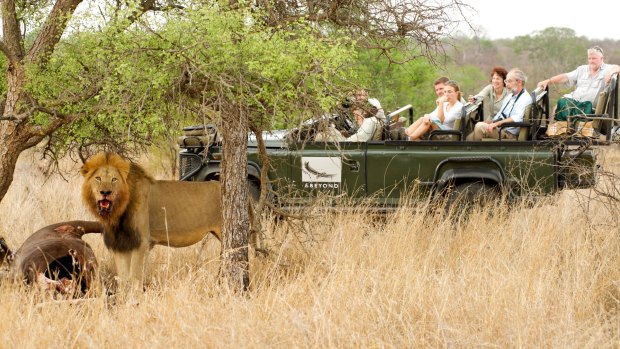
A lion with a buffalo carcass is watched by tourists on a game drive at &Beyond Ngala lodge in the Kruger Park area of South Africa.Credit: Alamy
Looking back it's hard to believe we were only at Ngala for two nights. That's enough to fit in two evening and two early morning game drives but we saw so much that I find myself doubting half of it happened.
It's like a wonderful dream, when you come to recall these events and the flotsam and jetsam of memory begin to coalesce and things you thought were figments become fragments, disparate moments in time rather than a linear progression from one event to another. What came first, the cheetah kill or the dung whisperer?
I remember the stripped-to-the-bone buffalo skeleton on the area known as Cheetah Flats; the beautiful but forlornly empty leopard tortoise shell we find on an afternoon walk; the fecund smell of a bull elephant in musth as it charges our jeep; the simple sparkle of post-rain droplets on the trees and acacia thorns in the early morning.
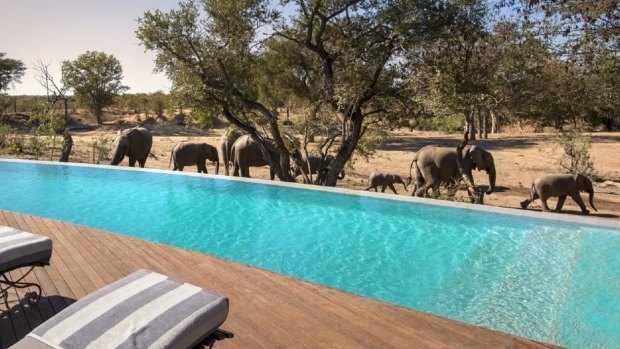
A herd of elephants walk besides the swimming pool at &Beyond Ngala Safari Lodge.
Did we really drive to a waterhole just before dusk and encounter, in quick succession, an eagle, several rhinos and an honest-to-goodness herd of elephants heading to the water in almost Disneyesque nose-to-tail procession?
Did we spy the snout and eyeballs of a crocodile in that same water as the baby elephants drank and sprayed water around with their wriggly little trunks? And were there really dozens of yawning hippos basking nearby?
***
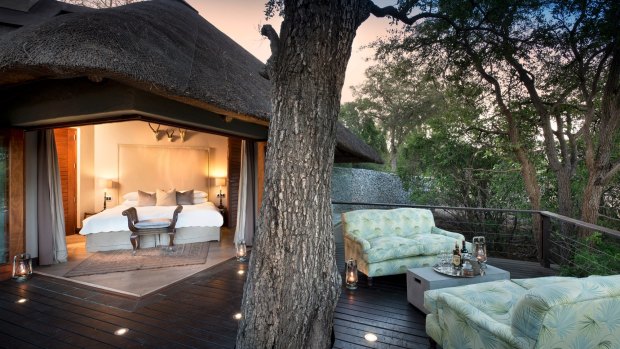
A verandah room at &Beyond Ngala Safari Lodge.
A fragment: we are being tossed around in the back of a jeep in a dry, sandy-soft riverbed when it happens. A bush buck explodes out of the scrubby brush on the bank, pursued closely by a cheetah in full flight.
It's over in a matter of seconds but it isn't an image that's likely to fade any time soon; the enormous, terrified doe-eyes of the buck, the preternaturally elongated body of the cheetah flying after it like a missile.
They disappear in the undergrowth and we think we've lost them until the cheetah emerges a little further along the riverbank, dragging the bush buck by its neck.
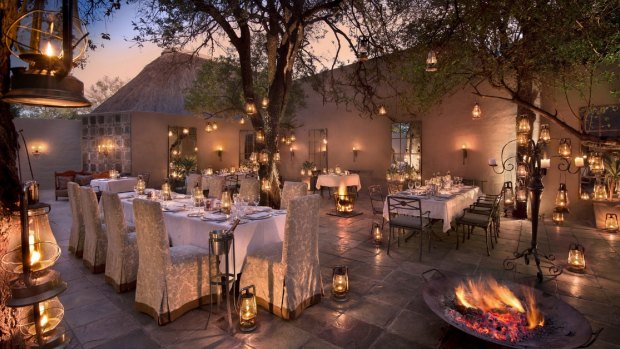
Outdoor dining in the courtyard at &Beyond Ngala Safari Lodge.
It's surprisingly neat. The cheetah's jaws are clamped around the buck's neck but there's no blood that I can see. It looks unharmed apart from the dangerously unnatural loll of its head. That and its protruding tongue, the still damp, slightly surprised eyes.
We also encountered that most marvellous of photographic clichés, the leopard high up in a tree with the floppy remains of a small antelope, which it was prissily arranging and rearranging like a wet beach towel.
Andre Scrimnger, our guide, laughs: "I really feel sorry for the next ranger you go out with … it's extraordinary that you've seen all this in just two days. I mean, no pressure, right?"
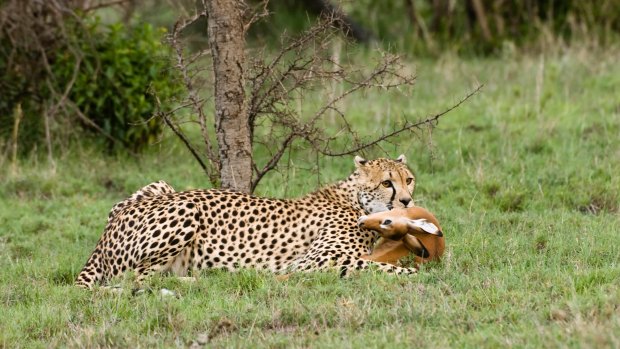
A cheetah with kill in its mouth in Kenya, Africa.Credit: Alamy
He's got a point. In just 48 hours we've seen painted dogs, lion, rhino, elephant, giraffe, buffalo, zebra, hippo, hyena, kudu, you name it. Plus, just for giggles, on the way back to the lodge after an evening game drive we encounter the most extraordinary bush baby (of which more later).
***
Ngala was the second of &Beyond's reserves to open, born in 1992 out of a three-way partnership between &Beyond, the World Wildlife Fund SA and the South African National Parks Trust. Today, the reserve covers some 15,000 hectares in South Africa's Kruger National Park.
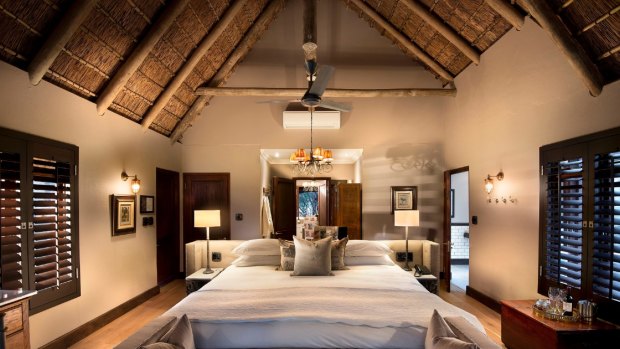
A family cottage at &Beyond Ngala Safari Lodge.
The lodge itself is pretty much the opposite of the land which surrounds it. Out there it's red in tooth and claw, a sun-parched landscape, crackling dry and prickly. There are no soft edges out there, unlike the bed in my villa, which is deeply luxurious and so large I keep expecting to find lemmings throwing themselves off the edge. And why there isn't a hippo in that standalone bath is anybody's guess.
There are just 21 airconditioned cottages and suites here and the general ambience is very much Dr Livingstone-I-presume old world colonial elegance shot through with African accents. It's all silverware and afternoon tea, wildlife in the waterhole, and theatrical fire-lit dinners under the stars in the secret boma out back.
***
A fragment: that flash of colour in the sere bush is the amazingly kaleidoscopic lilac breasted roller (now officially my favourite ever bird). We also see crowned lapwings, yellow hornbills, red-billed buffalo weavers, red-billed oxpeckers, Burchell's starlings and red-crested korhaans.
***
Fragments of conversations held and overheard:
"Zebras fart a lot. Some say it helps them run faster."
"For Joseph, looking at the animal tracks is like reading the morning paper."
"Mopane worms are a bit gross."
"Honey badgers are brutal animals."
"This is very interesting dung ..."
***
Memories of Andre Scrimnger's face when he talks about the land and the animals in it. Look up ''ebullient'' in the dictionary and you'll see him looking out at you.
On top of his fairly encyclopaedic general knowledge, he also has a thing about termites. Indeed, the man is positively priapic about them. We only have to pass a termite mound for him to start up again. Termites (and I am quoting him here) take matter down to an underground chamber, which is kept at a nutrient-rich 31degrees and where they grow a fungus that they then eat. A four-inch (100-millimetre) queen lays 30,000 eggs a day. There are 180 different termite species. "They are," says Scrimnger, "amazing creatures."
He does not, however, have an explanation for the bush baby that we come across on the way back from an evening drive. Tracker Joseph has been peering into darkness looking for nocturnal wildlife when he gives the signal to stop and turns the spotlight on.
In its glare is a tiny animal with big eyes, a sort of cross between a mouse and a severely malnourished wallaby. At first it is frozen to the spot but then this normally shy and retiring marsupial starts bouncing around the vehicle, just bounding straight up and down into the air like a child on a pogo stick. It is an extraordinary display that confounds everybody.
"Too much coffee?," quips someone eventually.
***
At some point we come across a pride of lions lazing around in a dry, scrubby clearing surrounded by viciously thorned acacia bushes. There are about 10 of them doing nothing much beyond yawning and flopping about like giant kittens. What's extraordinary is that the next morning we got back to exactly the same place to find them chowing down on a very fresh but very dead buffalo.
Lions, you see, do not drag their kills off to eat them. Where they die is where they get eaten. Which means this particular buffalo must have wandered right into the midst of a bunch of hungry lions. Oops.
"Like a pizza delivery," laughs one of the rangers as we watch one lioness devouring the hapless animal from the bum up. It's a somewhat ignominious end but as Andre Scrimnger says: "It's the circle of life."
He is so straight-faced, his eyes hidden behind sunglasses, that I cannot tell if he's taking the mickey or not. He's quoting The Lion King?
Then again, ''ngala'' is the local Shangaan name for lion. Which seems apt.
***
Flotsam and jetsam, figments and fragments – just a few little overlapping circles in the Venn diagram of life in South Africa.
TRIP NOTES
MORE INFORMATION
GETTING THERE
The Africa Safari Co arranges all flights and transfers. We went on South African Airways, which flies from all major Australian cities to Johannesburg via Perth. For extra information on flights and prices visit flysaa.com
A visa is not required to visit South Africa but, according to the Department of Foreign Affairs and Trade (DFAT) you are required to have a passport valid for no fewer than 30 days after the end of your intended stay. A valid Yellow Fever Vaccination Certificate is required for all passengers over one year of age who arrive or are transiting through South Africa from a country or region listed by the World Health Organisation as endemic for yellow fever.
A visa can be obtained on entry into Zimbabwe but it costs $US50. Cash is preferable as credit/debit card payments may not work.
Visas for Botswana can be obtained on arrival. If you are arriving from a country where yellow fever is endemic you will be required to present a valid yellow fever vaccination certificate to be allowed entry.
For detailed information on visas and vaccinations visit smartraveller.gov.au
TOURING THERE
The Africa Safari Co. is an Australian-based agency specialising in tailor-made safaris to Africa. For bookings visit africasafarico.com.au or call (02) 9541 4199 (Toll free 1800 659 279). For email inquiries, message enquiries@africasafarico.com.au
For details of &Beyond lodges visit andbeyond.com
Keith Austin was a guest of &Beyond and The Africa Safari Co.
Sign up for the Traveller Deals newsletter
Get exclusive travel deals delivered straight to your inbox. Sign up now.